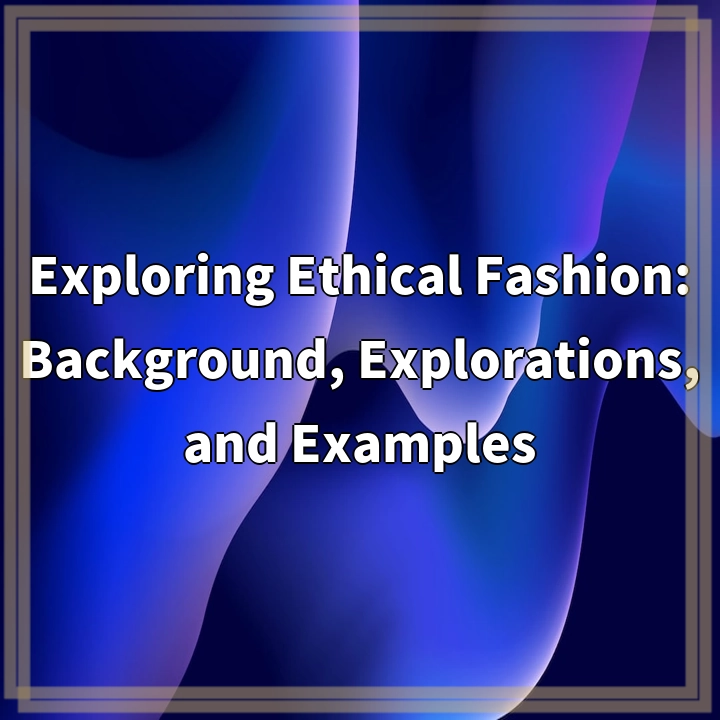
What is Ethical Fashion?
Ethical fashion refers to an approach to designing, producing, and consuming clothing that takes into consideration the social and environmental impact throughout the entire supply chain. It encompasses the sourcing of materials, fair labor practices, minimizing waste and pollution, and ensuring safe working conditions. Ethical fashion seeks to promote sustainability, fair trade, and the well-being of workers and communities involved in the fashion industry.
Real-World Problems Associated with Ethical Fashion
Ethical fashion emerged as a response to the detrimental effects of conventional fast fashion practices on both people and the planet. The fashion industry, traditionally driven by profit and mass production, has contributed to a range of significant issues:
Exploitation of Workers:
One of the most pressing challenges is the exploitation of garment workers, particularly in low-income countries. Many workers endure long hours, low wages, unsafe working conditions, and the denial of basic labor rights. Sweatshops and forced labor are persistent problems within the fashion industry, highlighting the need for fair and ethical treatment of workers.
Environmental Impact:
Conventional fashion practices generate immense environmental damage. From the extensive use of water for crop irrigation to chemical pollution from dyeing and fabric treatments, the industry is a major contributor to water pollution and habitat destruction. Additionally, the mass production and fast fashion model have led to excessive waste generation, as garments are discarded quickly, exacerbating landfill and waste management issues.
Lack of Transparency:
Inadequate transparency within the fashion industry makes it difficult for consumers to make informed choices. Genuine ethical practices are often concealed behind greenwashing or misleading marketing strategies. This lack of transparency creates ambiguity and makes it challenging for consumers to distinguish between genuinely sustainable and ethically produced garments and those that claim to be without any substantial evidence.
Overconsumption and Disposability:
The fast fashion model encourages overconsumption with frequent turnover of clothing items. This culture of disposability not only contributes to wastefulness but also perpetuates a cycle of exploitation and unsustainable practices. The demand for inexpensive and quickly produced garments leads to shortcuts in production, compromising both quality and ethics.
Supply Chain Complexity:
The fashion supply chain is complex and often involves multiple tiers of suppliers and subcontractors, making it difficult to monitor and address ethical concerns. From raw material sourcing to manufacturing and distribution, the lack of transparency and accountability poses challenges in ensuring ethical practices at every stage of the supply chain.

Solutions to Ethical Fashion Challenges
Addressing the real-world problems associated with ethical fashion requires collective efforts from various stakeholders, including consumers, brands, policymakers, and industry players. Here are some potential solutions:
Support Ethical Brands:
One of the most impactful actions consumers can take is to support ethical and sustainable fashion brands. By purchasing from companies that prioritize ethical practices, fair trade, and sustainability, consumers can encourage positive change in the industry and contribute to the demand for more responsible fashion.
Shift Towards Slow Fashion:
Embracing the concept of slow fashion involves opting for quality over quantity. It encourages investment in timeless, durable pieces that are made to last, reducing the urge for constant consumption. By supporting slow fashion, individuals can help combat the issues of overconsumption and disposability prevalent in the fast fashion industry.
Demand Transparency:
Consumers should demand transparency and ethical accountability from fashion brands. This includes asking questions about supply chain practices, sourcing of materials, and labor conditions. By supporting brands that prioritize transparency, consumers can contribute to creating a culture of responsible and ethical fashion.
Encourage Regulation and Policy Changes:
Advocacy for stricter regulations and policies regarding labor rights, environmental impact, and transparency within the fashion industry is crucial. Supporting organizations and initiatives that push for reform can help create systemic change and ensure that ethical standards are upheld throughout the entire supply chain.
Extend the Lifespan of Clothing:
Increasing the lifespan of clothing through proper care and repair is an effective way to reduce waste. Consumers can learn basic mending skills or support local tailors and repair services to extend the life of their garments. Additionally, donating unwanted clothing to charity or participating in clothing swaps and secondhand shopping can help minimize clothing waste.
Advocate for Fair Wages and Safe Working Conditions:
Supporting organizations that advocate for fair wages and safe working conditions for garment workers is crucial. By demanding brands to prioritize the well-being and rights of their workers, consumers can contribute to improving the lives of those involved in the fashion industry.















